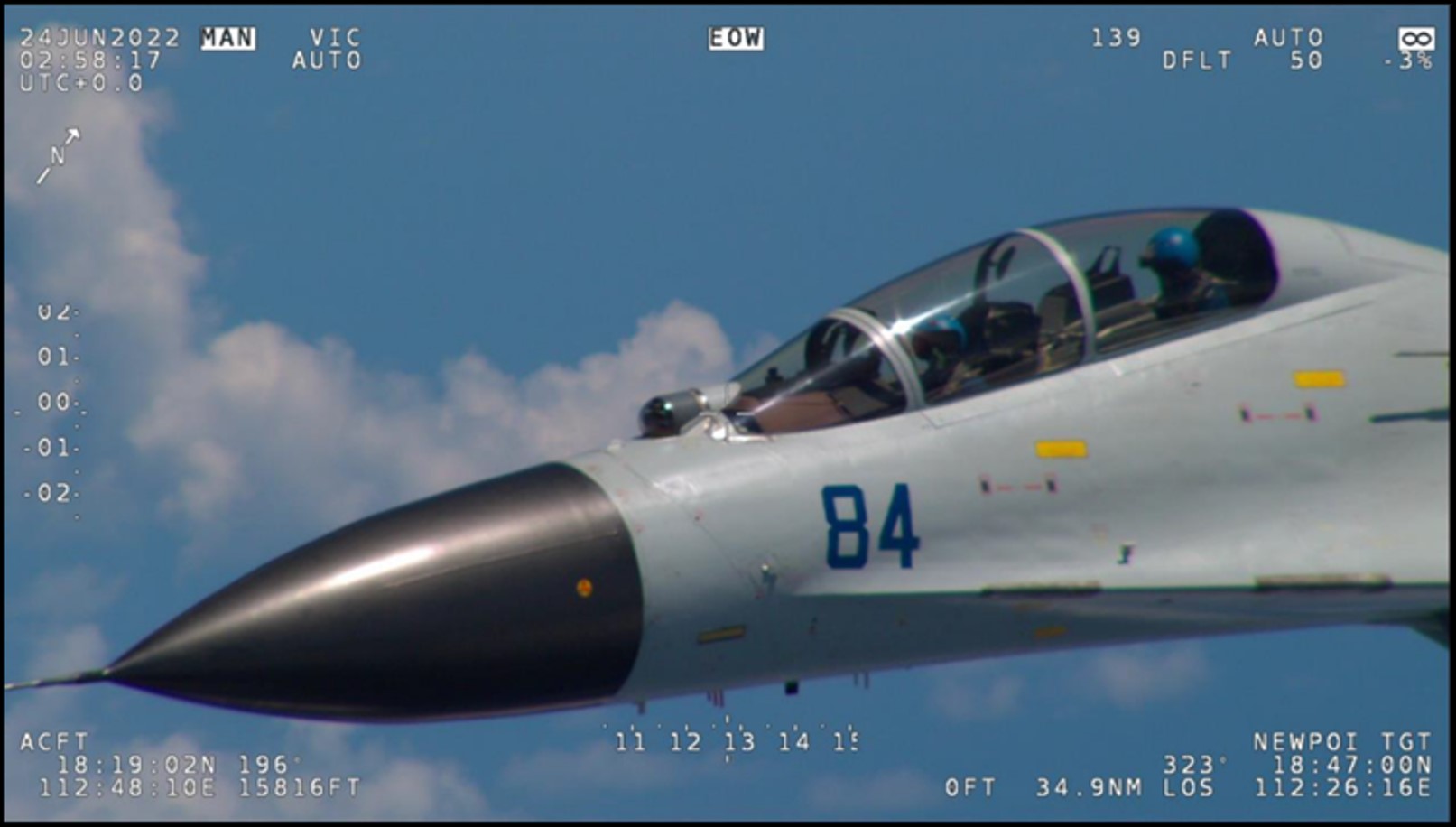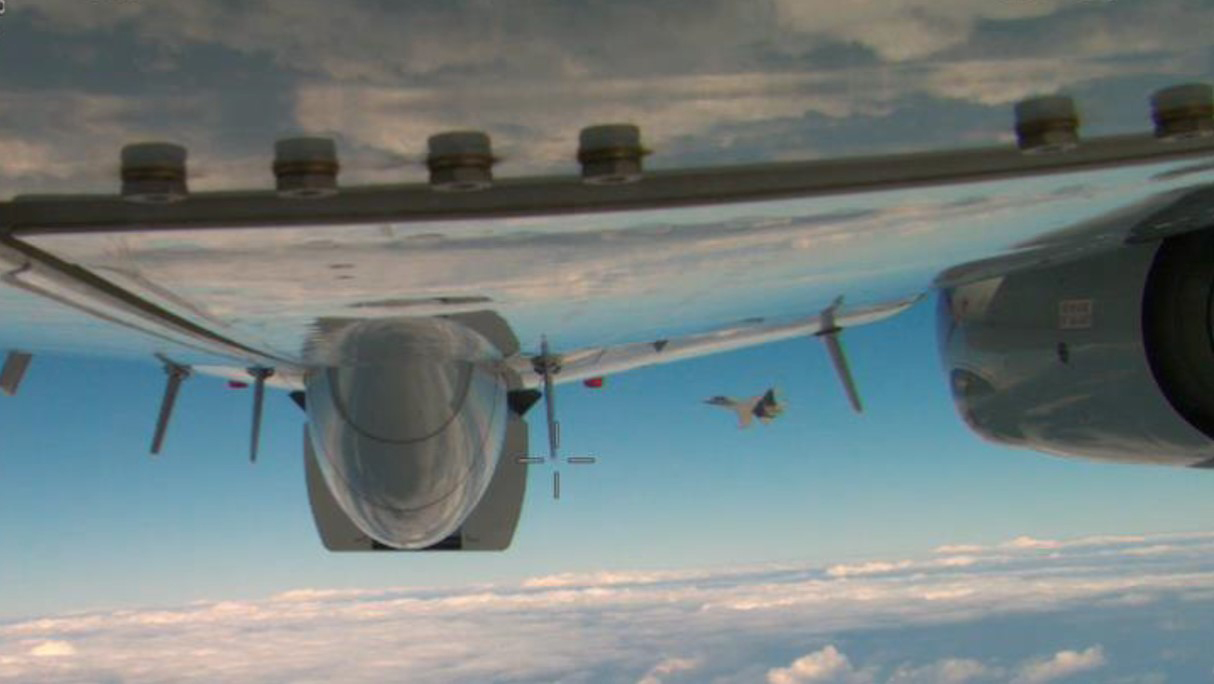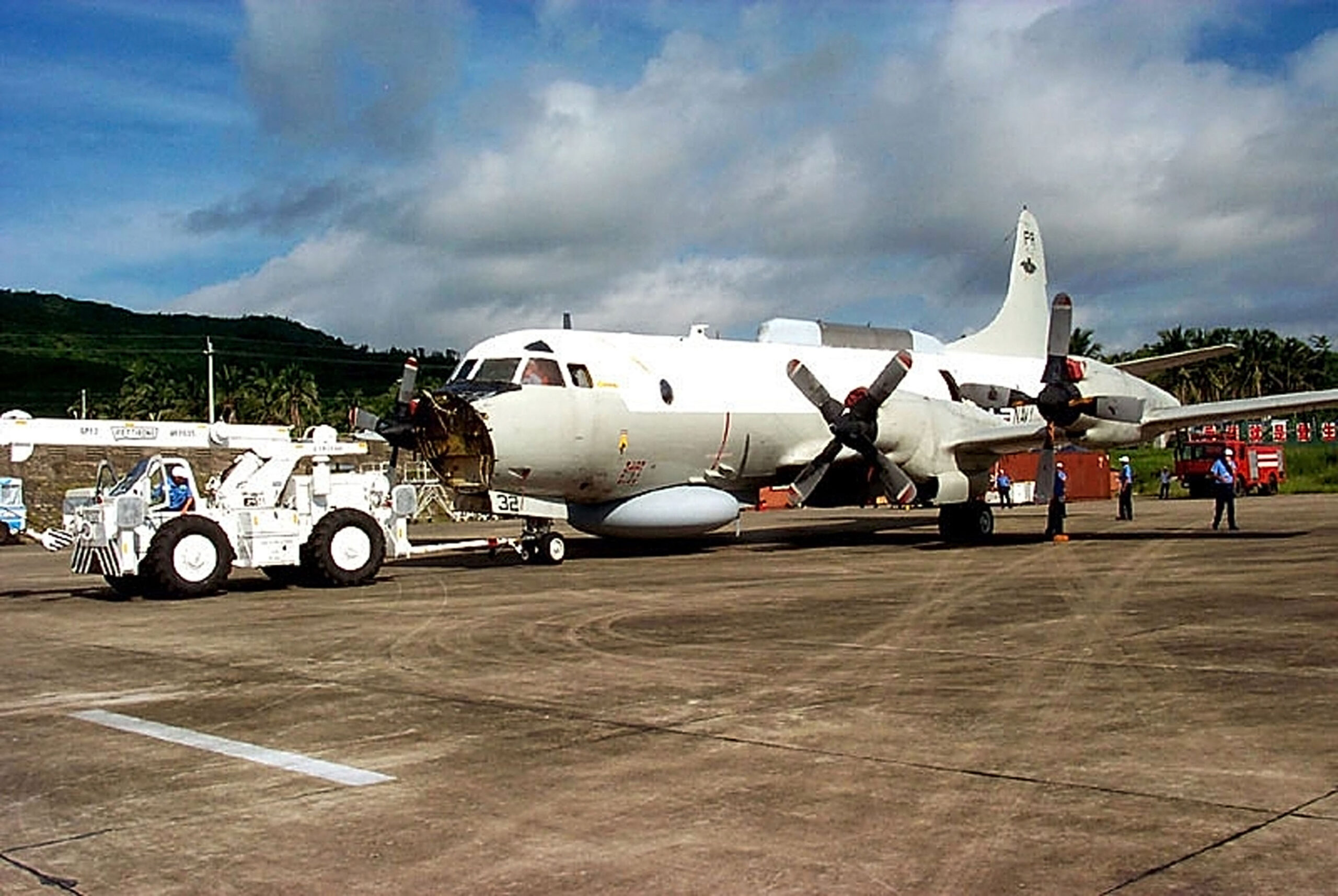The Pentagon has accused the pilot of a Chinese J-11 fighter of conducting an “unsafe intercept” of a U.S. Air Force B-52H Stratofortress bomber over the highly contested South China Sea. The intercept, the latest in a long sequence involving Chinese jets and aircraft operated by the U.S. military and its allies, comes after the announcement last week that B-52s had been deployed to Andersen Air Force Base, Guam, for forward-based Bomber Task Force operations.

In a media release today, U.S. Indo-Pacific Command Public Affairs provided a video of the intercept, which occurred on October 24.
The release states that the “J-11 pilot executed an unsafe intercept of a U.S. Air Force B-52 aircraft, which was lawfully conducting routine operations over the South China Sea in international airspace. During the night-time intercept, the PRC pilot flew in an unsafe and unprofessional manner, [and] demonstrated poor airmanship by closing with uncontrolled excessive speed, flying below, in front of, and within 10 feet of the B-52, putting both aircraft in danger of collision. We are concerned this pilot was unaware of how close he came to causing a collision.”

The video certainly shows the Chinese fighter approaching very close to the B-52, although to what degree there was a genuine risk of collision remains debatable. However, the intercept was conducted at night, with limited visibility, adding another level of danger. The J-11 can be seen fully deploying its dorsal airbrake to decelerate and hold station better with the bomber.
The footage was gathered using the Sniper pod mounted under the wing of the B-52, which is assigned to the 2nd Bomb Wing from Barksdale Air Force Base, Louisiana.
Flight trackers have revealed a pair of B-52Hs deployed to Andersen Air Force Base, Guam, conducting a mission over the South China Sea earlier today:
The intercepting fighter is a two-seat J-11 from the Chinese People’s Liberation Army (PLA). It’s not immediately clear if it was operated by the PLA Air Force (making it a J-11BS) or if it’s from the PLA Navy (J-11BSH). Either way, the aircraft is an unlicensed Chinese copy of the Soviet-designed two-seat Su-27UB. The J-11 carries air-to-air missiles, a typical procedure for these kinds of intercepts.

The fact that the U.S. Department of Defense has released video from the Sniper pod is interesting in itself, although embedded pod data displayed in the footage has been redacted. However, following the shooting-down of a Chinese surveillance balloon — and other unidentified objects — over North America earlier this year, the Pentagon had said that releasing air-to-air imagery (including even still screenshots) from the Sniper pod was impossible, due to the sensitive technology involved. Clearly, that wasn’t quite the case.
For the time being, however, the Pentagon is more concerned with what it claims is a growing list of China’s “unsafe, unprofessional, and other behaviors that seek to impinge upon the ability of the United States and other nations to safely conduct operations where international law allows” — to quote the 2023 China Military Power Report.
On October 17, meanwhile, the Department of Defense released a collection of declassified images and videos that it says provide evidence of “a dangerous pattern of coercive and risky operational behavior by the People’s Liberation Army (PLA) against U.S. aircraft operating lawfully in international airspace in the East and South China Sea.” Since the fall of 2021, the Pentagon says that there have been more than 180 such interactions.

Some of these incidents we have covered before here at The War Zone, including a J-16 fighter that in May 2023 “flew directly in front of the nose” of a U.S. Air Force RC-135 surveillance aircraft, forcing it to fly through its wake turbulence — an action known as ‘headbutting’ or ‘thumping.’
A J-16 performs an “unnecessarily aggressive maneuver” during the intercept of a U.S. Air Force RC-135 aircraft, over the South China Seaon May 26, 2023:

Other examples include a simulated attack on a U.S. Navy task group and a close-proximity intercept of another RC-135 by a J-11, both in December last year.
A People’s Liberation Army Navy J-11 performs an “unsafe intercept” of a U.S. Air Force RC-135 over the South China Sea, on December 21, 2022:

Prominent incidents from longer ago include a reported unsafe intercept of a U.S. Air Force WC-135W Constant Phoenix atmospheric sampling jet by a pair of Su-30MKK fighters above the East China Sea, which you can read more about here. Most notoriously, an unsafe intercept by a Chinese J-8 Finback fighter led to the infamous Hainan Island Incident in 2000, when a collision with a U.S. Navy EP-3 Aries spy aircraft resulted in an emergency landing at a Chinese airbase and a major diplomatic row.

Intercepts by Chinese aircraft have been going on for decades and are a regular part of operations over the South China Sea, in particular.
But however dangerous or not the most recent interaction, between J-11 and B-52, there does seem to be a pattern of increasingly belligerent behavior by Chinese aircraft. In June 2022, for instance, a Royal Australian Air Force P-8A Poseidon maritime patrol aircraft was reportedly damaged by countermeasures launched by a Chinese J-16 over the South China Sea.
For the United States, it’s imperative that U.S military assets are able to operate wherever international laws allow. This is of particular importance in the Indo-Pacific region, where Beijing has a very different understanding of what constitutes international airspace and international waters, and what is its sovereign territory.
Ultimately, whether professional or not, the stakes are very high in these interactions over the South China Sea, in particular, due to the simple fact that Beijing claims the vast majority of these waters as its own. This results in longstanding tensions between Beijing, its neighbors, the United States, and its allies.
With China meanwhile embarking on increased militarization of the South China Sea region, most prominently via the construction of man-made island fortresses in these waters, the friction here has only grown.

Coupled with these territorial claims are the lingering concerns over a potential Chinese move against Taiwan, with U.S. officials now speaking fairly openly about the prospect of Beijing seeking to take control of the island sooner rather than later, Beijing having taken an increasingly aggressive stance toward the island in recent years has done nothing to allay those fears.
For the time being, as long as U.S. and allied aircraft continue to exercise their right to operate in international airspace, and as long as China’s own territorial claims are at odds with this, then similar aerial encounters are likely to remain a regular occurrence.
Contact the author: thomas@thedrive.com

